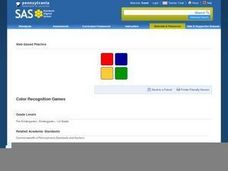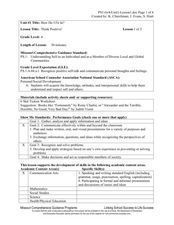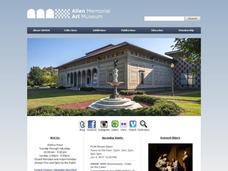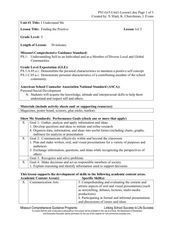Pennsylvania Department of Education
Writing With Environmental Print
Students develop literacy skills by exploring street signs, cereal boxes, and billboards. In this writing with environmental print lesson, students build word recognition in every day print. Students decode words and discover new words.
Pennsylvania Department of Education
Creating Polygons
Pupils describe, make and compare polygons. In this creating polygons lesson, students identify properties of quadrilaterals and describe common features of two dimensional shapes.
Curated OER
Letter Recognition Flash Games for Kids
Students explore the alphabet by completing an on-line letter identification activity. In this phonetics activity, students utilize the website www.literarycenter.net and listen to word sounds as they identify the spelling of the...
Curated OER
Color Recognition Game
Students study color words. In this math lesson plan, students complete a variety of activities on the computer in which they identify colors and color words.
Pennsylvania Department of Education
The Letter B (b)
Students discover words through text, audio and images that begin with the letter B. In this letter B lesson, students download an ebook and navigate through an interactive reading activity.
Curated OER
The Interactive Periodic Table of the Elements
Students study the different types of metals. In this investigative lesson students watch a demonstration on the effects of temperature on atoms and take a tour through baone matter.
Curated OER
Save the Earth: It's Everyone's Home
Students explore how recycling helps save trees and protect the environment. In this environmental concern lesson, students color a handout of animals that live in forests. Students discuss how recycling paper can save trees and set up...
Curated OER
What is an Animal Group?
Students discover that people live in groups and animals live in groups or alone. They list ways that families cooperate and work together as a group. They create a large dinosaur made out of geometric shapes.
Curated OER
Make a Cast of a Tyrannosaurus rex Fossil
Second graders examine the formation of fossils and list the different types. They make cast model of a dinosaur fossil. They write about conditions that are necessary for fossils to form and create a model of a buried fossil.
Curated OER
Benjamin Franklin's Wisdom
Students explore Benjamin Franklin's personal accomplishments and his wisdom on self-discipline. In this social studies lesson, students analyze Benjamin Franklin's quotes and discuss their meaning. Students share with the class.
Curated OER
Presidents: Past and Present
Students identify George Washington and the current president and distinguish between past and present events. They listen to a text about Washington and make predictions. They generate a list of synonyms for past and present and...
Curated OER
Make a Dinosaur
Students estimate the size of dinosaurs and create a dinosaur model. They create bar graphs of the sizes of dinosaurs one in meters and the other in "student" units. They draw a pictures and add words or sentences about their dinosaur.
Curated OER
Pond Exploration
Students take a hands-on approach to explore the world beneath the water in this activity. They examine the creatures they catch to study about the adaptations these animals have that allow them to survive in this harsh environment. They...
Curated OER
Underground Railroad
Eighth graders explore the Underground Railroad. In this American History lesson, 8th graders create a song about the railroad. Students analyze various symbols used during the Underground Railroad.
Curated OER
From Seeds to Plants
Second graders review the process of plant reproduction and the role of seeds in that process. The students dissect a seed, analyze their finds, collect and record data, and make predictions about seed germination and plant growth.
Curated OER
The Gift of Community
Students explore the diversity offered in communities. In this Teaching Tolerance lesson, students read The Gift and then interview people within their school community regarding the gifts they receive in their community.
Curated OER
Think Positive!
Fourth graders are read a story in which they identify the positive and negative thinking. In groups, they are given a scenerio in which they change the negatives into a positive. They perform the scenerio to tthe class and discuss how...
Curated OER
Japanese Carp Kites/Children's Day
Students listen to the story "A Carp for Kimiko" and discuss its lesson and theme. They design and create their own carp kite in celebration of Children's Day. They discuss gender discrimination and how that makes them feel.
Curated OER
Japanese Carp Kites
Students listen to the story A Carp for Kimiko and discuss its theme/lesson. Then they identify and are introduced to the Japanese holiday, Children's Day, formerly known as Boy's Day. Students also design and create their own carp kite....
Curated OER
Finding the Positive
Fifth graders meet the "Famous Artist." They are introduced to the topic of self-concept. Students work in small groups and get organized to create collages. They create a collage that represents characteristics of positive self-concept.
Curated OER
Traveling the Career Paths 1
Students explore careers. In this life goals lesson plan, students examine several career paths as they listen to puppets present different types of jobs and discuss the importance of each of the jobs.
Curated OER
Completing Applications
Tenth graders determine the importance of exemplary job applications. For this job application lesson, 10th graders examine job applications that have been filled in poorly and those that are done well. They complete job applications and...
Curated OER
Kokeshi Dolls
Students create Kokeshi Dolls using paints, dowel ends and glue. They research the traditions and history of Hina Matsuri, or girls' day in Japan.
Curated OER
Traveling the Career Paths 2
Students discover the six different career paths they could take and why each path is important. In this career choice lesson plan, students discuss different career paths using a visual poster. Students then play interactive games.

























